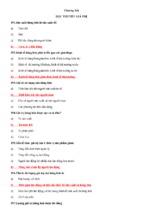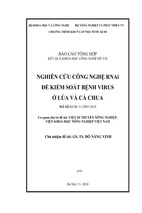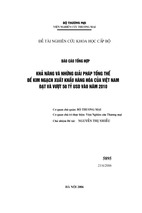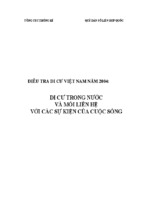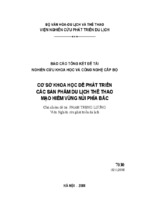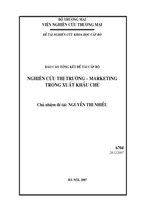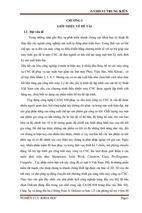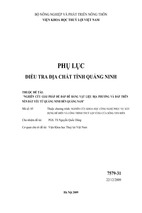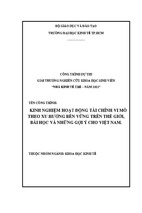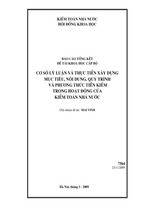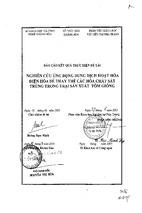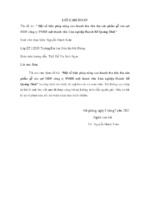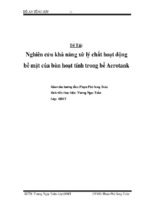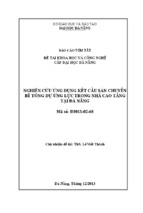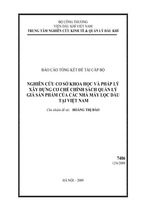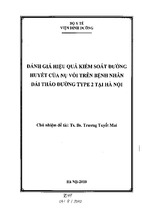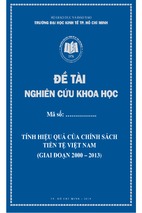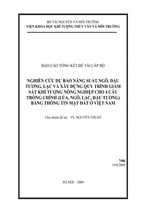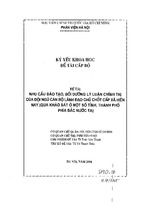THE IMPACT OF CORPORATE SOCIAL RESPONSIBILITY (CSR) ON BUSINESS
PERFORMANCE
BY
LE MINH HOANG
E0700038
Graduation Project Submitted to the Department of Business Studies, HELP University
College, in Partial Fulfillment of the Requirements for the Degree of Bachelor of
Business (Accounting) Hons
OCTOBER 2011
DECLARATION OF ORIGINALITY AND WORD COUNT
I hereby declare that the graduation project is based on my original work except for quotations
and citations which have been duly acknowledged. I also declare that it has not been
previously or concurrently submitted for any other course/degree at Help University College
or other institutions. The word count is 12,718 words.
LE MINH HOANG
17th October 2011
1
ACKNOWLEDGEMENT
This project would not have been made possible without the assistance, support and
encouragement of many people. I wish to take this opportunity to thank all the people who
have helped me during the time of completing the dissertation.
Firstly, I would like to express my deep gratitude to my supervisor Dr. Le Van Lien,
International School, Vietnam National University Hanoi. He has kindly helped me and
supported me all the way through. For that, I am very grateful. I also would like to express my
thank to Ms. Sumathi and Ms. Shenba, Help University College, who initiated the project and
give so much instruction and support.
Additionally, I would like to thank the interview participants who took their precious time to
help me to conduct the interview. I also would like to extend my special thanks to my family,
my friends, and other people who have help me to carry out the survey. I want to thank them
for all their support, interest and valuable hints.
LE MINH HOANG
2
THE IMPACT OF CORPORATE SOCIAL RESPONSIBILITY (CSR)
ON BUSINESS PERFORMANCE
By
LE MINH HOANG
October 2011
Supervisor: Dr. Le Van Lien
ABSTRACT
CSR has become a burning issue in the world. As Vietnam is one of the world’s fastestgrowing economies, CSR has become even more important for the country to develop
sustainably. This paper aims to discover how the CSR impact on the business performance of
companies in Vietnam. It also give a view CSR and CSR reporting, whether CSR information
have any effect on the Vietnam customer behavior, and the attitude of Vietnamese employees
toward CSR reporting. The results of the study provide evidence that there is strong support
for CSR from managers and a growing awareness among consumers and employees.
However, there is expectation gap between how people perceive and how people act because
there are lack of adequate CSR disclosure from firm, and not-so-enthusiastic support actions
from consumers due to the barriers in living expenses, and low effective CSR communication
tools that companies use. However, with highly positive attitude toward the important of CSR
and the willingness to learn and gain more knowledge about this issue found from the survey
have drawing potential bright future for CSR in Vietnam.
3
TABLE OF CONTENTS
DECLARATION OF ORIGINALITY AND WORD COUNT............................................ 1
ACKNOWLEDGEMENT ....................................................................................................... 2
ABSTRACT .............................................................................................................................. 3
CHAPTER 1: INTRODUCTION ........................................................................................... 9
1.1
Research background ................................................................................................ 9
1.2
CSR in Vietnam ....................................................................................................... 10
1.2.1
Government actions and policies ....................................................................... 10
1.2.2
CSR practices, opportunities, and challenges .................................................... 11
1.3
Problem statement ................................................................................................... 12
1.4
Research objectives.................................................................................................. 14
1.5
Research methods .................................................................................................... 14
CHAPTER II: LITERATURE REVIEW ............................................................................ 15
2.1 CSR definition ............................................................................................................... 15
2.2 Research related studies and concepts........................................................................ 15
2.2.1 Model "pyramid" of Carroll ..................................................................................... 15
2.2.2 Triple Bottom Line .................................................................................................. 16
2.2.3 CSR and Sustainability investing............................................................................. 18
2.2.4 CSR and Business ethics .......................................................................................... 19
2.2.5 CSR Report .............................................................................................................. 19
2.3 Hypothesis ..................................................................................................................... 20
2.3.1 CSR and the role of manager ................................................................................... 20
2.3.2 CSR and the role of employees ................................................................................ 21
2.3.3 CSR and the role of customers................................................................................. 22
4
CHAPTER 3: RESEARCH METHODOLOGY ................................................................. 23
3.1 Research objectives....................................................................................................... 23
3.2 Research methodology ................................................................................................. 23
3.3 Data sources .................................................................................................................. 23
3.3.1 Primary data ............................................................................................................. 23
3.3.2 Secondary data ......................................................................................................... 24
3.4 Research method........................................................................................................... 24
3.5 Research tool ................................................................................................................. 24
3.5.1 Questionnaire ........................................................................................................... 24
3.5.2 Personal interview .................................................................................................... 25
3.6 Sampling ........................................................................................................................ 25
3.6.1 Sampling population ................................................................................................ 25
3.6.2 Sample frame ........................................................................................................... 25
3.6.3 Sample size .............................................................................................................. 25
3.7 Limitations .................................................................................................................... 26
CHAPTER 4: FINDING AND ANALYSIS ......................................................................... 27
4.1. Management ................................................................................................................. 29
4.1.1. Finding from the questionnaire survey ................................................................... 29
4.1.2. Actual CSR disclosure by firms .............................................................................. 34
4.1.3 Overall assessment of management’s responses ...................................................... 34
4.2. Employees ..................................................................................................................... 36
4.2.1. Finding from employee questionnaire survey......................................................... 36
4.2.2. Overall evaluation of employee’s responses ........................................................... 40
4.3. Consumers .................................................................................................................... 41
5
4.3.1. Finding from consumer questionnaire survey......................................................... 41
4.3.2: Overall evaluation of consumer’s responses .......................................................... 45
4.4 Overall discussion ......................................................................................................... 46
CHAPTER V: CONCLUSION AND RECOMMENDATION .......................................... 48
5.1 Conclusion ..................................................................................................................... 48
5.2 Recommendation .......................................................................................................... 48
5.3 Limitation of study ....................................................................................................... 49
5. 4 Suggestion for the future research ............................................................................. 50
References ............................................................................................................................... 51
Appendix ................................................................................................................................. 55
6
LIST OF FIGURES, DIAGRAM, AND IMAGES
Figure 2.1
The Carroll’s “Pyramid of CSR” ............................................................... 16
Figure 2.1
Triple Bottom Line ..................................................................................... 18
Figure 4.1:
Respondents ............................................................................................... 27
Figure 4.2:
Employee categories .................................................................................. 28
Figure 4.3:
Consumer categories .................................................................................. 28
Figure 4.4
Distribution of responses from management survey .................................. 29
Figure 4.5.
Distribution of responses from management survey (percentage) ............. 33
Figure 4.6.
Distribution of responses from employees' survey .................................... 36
Figure 4.7:
Distribution of response from employee’s survey ..................................... 39
Figure 4.8:
Distribution of responses from consumer survey ....................................... 41
Figure 4.9:
Distribution of responses from consumer survey (percentage) .................. 45
7
LIST OF ABBREVIATIONS
CSR
Corporate Social Responsibility
CSP
Corporate Social Performance
IAS
International Accounting Standard
WTO
world trade organization
APEC
Asian pacific economic organization
ASIAN
Association of southeast Asian nations
NGO
Non-governmental Organization
PR
Public Relation
TBL
Triple Bottom Line
VSA
Vietnamese Accounting Standard
8
CHAPTER 1: INTRODUCTION
1.1 Research background
The concept of Corporate Social Responsibility (CSR) has issued in the early of the 1970s,
CSR has become very popular for the companies especially companies which are running
business in the developed countries. With the major relationship between business and society
reflected by CSR, nowadays, CSR is not only the current affairs of companies which are
running business in the developed countries, it also is the current affairs of companies which
are running business in the developing countries.
With the three major issues of CSR are labor, environment, and finance. Companies are
paying more attention on the CSR in the way performing well CSR activities to improve
competitive advantages and reputation in the market. The companies take care about their
internal stakeholders such as employees’ healthcare, working environment will raise their
loyalty, it will lead to increase productivity and may lead to increase profit for companies.
Nowadays, companies are influenced by many parties which are related to CSR. Especially,
international companies which are not running business in only one country, so they have to
follow law in control of CSR of each country they do business. More than that, they have to
follow the rules of World Trade Organization (WTO) or other organization such as Integrated
Reporting Committees (IRC), and World Council for Sustainable Development (WBCSD)
which are applied for over the world. By following the rules of the organization above, and
doing well CSR activities, companies can build their strong reputation and reliable in the view
of public, so they can make shareholders confident to invest, customers also prefer to buy
their products and services, and governments also have sympathy with them and may offer
more benefits to attract them to invest in that country.
9
1.2 CSR in Vietnam
Vietnam is a developing country, so in the previous the government and companies are not
pay much attention on the CSR. However, with the globalization trend and especially after
joined World Trade Organization (WTO) on 11th January 2007, Vietnam’s economy is
entering more deeply into the world economy, so to capture the benefits in this case Vietnam
has to change the attitude of CSR to get the accept of goods and services distribution into
developed countries. However, Vietnam economy is still small and much lower development
to compare with the developed countries, even to compare with some countries in the ASIAN
such as Thailand, Singapore, and Malaysia. Therefore, the pressure of catching up these
economies lead the CSR is to be ignore sometimes and still is a new concept in Vietnam even
Vietnam has joined most of the economic and political organization and association in the
world such as WTO, ASEAN, ASEM, APEC, IMF, World Bank, and some General
Agreement on Tariff and Trade (GATT) with some countries, so companies in Vietnam will
try to reduce cost pay for CSR to maximize profit.
1.2.1 Government actions and policies
Vietnam was running centralize economy until 1986, in this period Vietnam economy is
closed so companies is under the control of government, and they don’t have to face CSR
pressure from government, and the government also ignore CSR concept. However, from
1986 Vietnam is following the open door policy. With many competition advantages such as
low labor cost, plentiful resources, Vietnam has easy to attract a lot of investors to invest in
there and Vietnam has got very successful with the high economic growth. However,
Vietnamese government focuses too much on the economic growth and may be ignore the
10
CSR activities, so it allow many companies to bring old technology into Vietnam, and the
foreign companies also take these advantages to maximize profit by ignore or maximize
reducing CSR cost. This is reason lead to many problems Vietnam has to face such as social
problem. Awareness of these problems, Vietnamese Government has created many
regulations such as Environment Protection Law, Labor Law, and Consumer Protection Law.
More than that, in the recent year Vietnam has established environment police department to
manage and punish companies which make pollution. In additional, Vietnam also offers more
benefits for companies with advanced technologies when invest in Vietnam, and avoid
companies with old technologies.
1.2.2 CSR practices, opportunities, and challenges
With the awareness of CSR and the traditional and culture of companies, many companies
when invest in Vietnam had practiced very well CSR activities such as set up charitable funds
and do many social activities of Coca-cola Vietnam, Honda Vietnam, Dutch lady. However,
some foreign companies are still tried to ignore CSR activities to maximize their profit and
they have made some scandal related to CSR such as Vedan Vietnam has made pollution in
Thi Vai river. The companies that ignore CSR may forgot that CSR also brings some
opportunities for them. For example, the European Union, Japan require products imported
must follow the ISO 9000 and14000 series (which focus on the environmental management
standards). So doing well CSR in this case will allow companies to export products to these
countries. Even realized that CSR may bring some opportunities for companies, but some of
them are still in a divided mind to pay more for CSR or not because CSR activities will cost
quite a lot of money and time. More than that, the awareness about CSR of customers in
11
Vietnam is still limited, so companies which have strong CSR activities may face a challenges
when compete with companies do not apply CSR because these companies have to pay no or
less cost on CSR so their products and services may cheaper. Another challenge is lacking of
law enforcement in Vietnam. For example, companies do CSR activities sometimes may not
get tax deduction because laws relate to CSR are not perfect, so companies will be loss money
and the profit also reduce.
1.3 Problem statement
When companies export their products and services, they have to satisfy the demand of
customers, more than that, Vietnam has joined many economic and political organization and
association in the world such as WTO, ASEAN, ASEM, APEC, IMF, World Bank, and some
General Agreement on Tariff and Trade (GATT) so CSR become more and more popular and
sometimes is the necessary condition for companies do export their products and services.
More than that, the living standard of Vietnamese is much higher than in the year 1990s so
they also require not only high quality product, they also require companies have to protect
environment. The employees also have many choices when they apply for job, so if
companies want to attract high skill employees, they must offer more welfare for them and the
Government also has choice to select the investors, so investors will try the best to show their
CSR activities to get more support from Vietnamese Government.
Even the Vietnamese government and public in Vietnam are paying more for the CSR, there
are still many problems related to CSR made by both foreign and inland companies. Most of
the CSR problems related to the environment pollution. In the recent year, the hottest scandal
12
related to CSR is the case of Vedan Vietnam which is Taiwan international company. Vedan
has made pollution in Thi Vai river, which affected many people live and doing business
around Thi Vai river. This problem lead to the result that customer in Vietnam reject the
products of Vedan.
Another problem related to CSR is the unsafe products. Many companies in Vietnam have
problem with unsafe product such as products over date usually be renew to cheat customers.
Food and drink also is the main field that related to unsafe product that make many people got
food poison, more than that, in Vietnam also discovery the milk with melamine. This is
serious problem because it affect direct to the health of customers. Chemical also is the field
that involved in the unsafe products with many case find out the 3-MCPD in the products.
More than that, many medicines in Vietnam is the fake medicines, so it is not useful in cure
for customers, and sometimes these medicines contain poison for the patients.
Working condition of employees also is the problem relate to CSR in Vietnam. The research
show that in Vietnam in 2009 there were 6200 working accidents (increased 7, 09 %). The
causes of these accidents are mainly from the human (employers’ mistakes are 75%, the
employees' mistakes are 18, 5%). Total damage to property is more than 42 billion and more
than 450,000 working days. In the whole country, 26,700 workers have had occupational
diseases. Even the labor law has issued in Vietnam, some companies are still ignore the safety
of employees because they want to reduce cost or to meet the progress of the project as in the
case of Keangnam group. More than that, some companies do not take care about the working
condition and have too much overtime working with no higher salary was lead to many strike
such as in Binh Duong, Hai Duong.
13
1.4 Research objectives
This research will focus on summarize the CSR concepts and its definitions. Evaluate the
awareness of both inland and foreign companies in Vietnam about CSR concept, practices, its
importance and benefits. This research also gives the recommend some solution for
companies in Vietnam to raise the CSR activities.
1.5 Research methods
Besides using the second data, in this research will distribute the questionnaire and conducts
the study of managers, employees, and customers in Hanoi. Interview also can be use in this
research by interviewing each individual from managers, employees, customers for the
survey.
14
CHAPTER II: LITERATURE REVIEW
2.1 CSR definition
The concept of CSR has been used widely since 1960s, from 1960s to 2011 is very long
period, so with the development of economic, social, the definition of CSR also changes to
meet the requirement of the fact. Nowadays, there are many definition of CSR introduced by
many researchers and organizations. According to the World Business Council for
Sustainable Development in it publication “Making good business sense” by Lord Holme and
Richard Watts, the definithion of CSR is “The continuing commitment by business to behave
ethically and contribute to economic development while improving the quality of life of the
workforce and their families as well as of the local community and society at large” [1].
Because CSR is affect direct or indirect to the company’s performance, employees’
motivation, customers’ loyalty and company’s reputation, so each company will choose the
way to do CSR to meet the requirement of customers, employees, and society.
2.2 Research related studies and concepts
2.2.1 Model "pyramid" of Carroll
Together with the development of economic, the concept of CSR also develop very fast so we
can easy to find out many different view of CSR
each view may suitable for a certain
country, industry, or company. However, the pyramid of A.Carroll (1999) is comprehensive
and acknowledged over the world. In this model CSR included economic, legal, ethical and
charitable. All of these components will response to maximize economic benefits, competitive
advantages, efficiency and growth. With the motto “a good company – a great corporate
15
citizen”, CSR is the necessary condition for business get success and strong CSR also is the
profit of company owners. More than that, company is a part of society, so any activity of
company will affect on the society depend on the size of company.
Figure 2.1 The Carroll’s “Pyramid of CSR”
2.2.2 Triple Bottom Line
Triple Bottom Line was first mention in 1981 by Freer Spreckley, there are three bottom lines
are economic line, social line and environmental line. In the previous, the managers are
mostly followed the profit objective. However, if they forget the environment and society, so
how long can they make profit, remain profit. So they should also take care about the
environment and social line to make profit in the durable way.
16
A company has bad relationship with employees or local community may difficult to
develop, even exist. If company and employees are not in good relationship, the employees
will not try hard to work, so the productivity will be less, the high skill employees may not
prefer to work anymore, and more than that, it may lead to the strikes which make company
cannot running. All of the activities about result to the performance of company become less
effective and the profit also decrease. If company has good relationship with employees, they
can motivate them to work more effective and efficient, so it will make the profit increase. To
do that company should improve working condition, set up a good welfare policies, have
policy to award employees when they are working with the effective and efficient, and also
should take care about employees’ family such as offer healthcare insurance for their wife or
children. Besides having good relationship with the employees, companies also should have
good relationship with the local community because people living in the local community
may be is the major customers or the employees are also living there. To have good
relationship with local community, companies should do volunteer and communicate with
local people by support the fees for the local community activities, motivate employees to join
these activities to make close to them. Even these actions are useful for companies, but
companies also should consider about the cost to ensure that it is not affect on the profit of
company.
17
Figure 2.2 Triple Bottom Line
Another factor that company should consider is environment. Most of companies realize that
negative impact on environment will make the falling in reputation of company, and
customers also tend to avoid products and services of company. However, if company takes
care about environment and protects it, the public will have more sympathy about company
and this may become an advantage of company. To do this, company can choose many ways
such as saving raw materials, reduce waste or recycle it. However, to protect environment,
company may have to pay a lot of money for new technology, and other costs. Therefore,
company should consider the way to protect environment to make it become an advantage of
company, not a cost burden for company.
2.2.3 CSR and Sustainability investing
Sustainability investing mention the clearly recognition that economic, social, environmental
and ethical are the factors that directly affect business strategy. In some case, company wants
18
to protect environment by invest for new technology. However, it cost too much money and
company has to face falling in profit for this environment protection. So company may change
its strategy to apply the technology which may cost less but also protect environment less.
More than that, in some case it is responsible investing, so company has to consider how to
invest to make the balance between ethical and sustainable investing. If they have no ability to
invest in one time, company should divide it into various processes to get on the sustainability
investment and protect environment.
2.2.4 CSR and Business ethics
“Business ethics is expressed as the standards and principles are social as well as the business
world recognizes, as the rules of behavior, the professional relationship between managers
with one another, or between managers value to society in the process of conducting business
activities, allowing managers to behave honestly and responsibility to the community and
with each other. Business ethics is a manifestation of the balance between the interests of
managers in implementing the business objectives with the interests of the employees work
for managers, customer benefits, the partners and the interests of the community in general”.
So when doing more CSR activities, company will raise their business ethics but it also put
them into the situation of choosing between profit and business ethics which one is more
important and necessary at that time.
2.2.5 CSR Report
Nowadays, both internal and external are not only pays attention on the financial report of
19
- Xem thêm -

